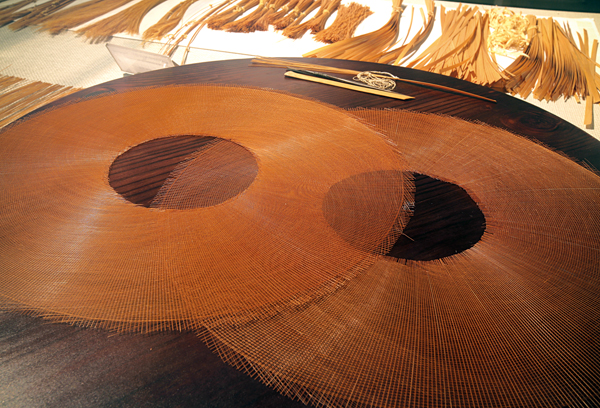|
Present day headwear in the Land of the Morning Calm is much like any other developed country. Sit by the window of a trendy coffee shop and it is quickly apparent that baseball caps are the order of the day, giving way to woolly hats as cold weather draws in.
Despite the ubiquity of today’s mass-produced head garments, it might be surprising to learn that Korea was once known as the “Nation of Hats,” particularly due to the gat — a black, cylindrical hat with a flat top, a wide brim, and a bamboo frame.
| |
 |
|
| |
This particular hat’s design abounded in social meaning, denoting the wearer’s wealth as well as social and marriage status, developing an attendant culture, one integral to Korean society.
So ingrained was gat culture that it even signified one’s place in the Joseon caste system, and those considered untouchable — or baekjeong — were strictly forbidden from wearing it. Only married yangban — upper-class scholars — who had passed the prestigious civil service exams were allowed to wear the sought-after adornment.
Such was the extent of its class-symbolism, that the abolition of the gat was demanded by the peasantry as a way to end social restrictions on traditional clothing and became central to the Donghak Peasant Rebellion of 1894.
A further and more serious assault on this head attire came in the form of the fall of the Joseon Dynasty and the subsequent Japanese occupation, which sounded the death-knell for gat culture. The following 35 years of Japanese rule saw all expression of Korean culture ruthlessly suppressed, leading to an unavoidable decline in Korea’s unique hat-wearing conventions.
| |
 |
|
| |
Despite its absence on the streets of this rapidly changing country, the gat retains a special place in the Korean collective consciousness. In fact, the traditional method of gat-making is not only a national treasure in the sentimental sense, it has also been officially designated Intangible Cultural Asset No. 4. So important are gat-making skills to Korean culture that they were among the first cultural properties to be pro-tected in the 1960s.
Perhaps to guard against potential distractions, the gat-making process is divided into three distinct parts: the making of the yangtae (the brim) from the finest quality bamboo; the making of the chongmoja (the cup-shaped upper hat) from fine horse hair; and the process of ipja (assembling the rim with the bowl of the hat to complete the gat).
The instantly recognizable wide yangtae hints at the gat’s function, as exposed hair was considered indecent among polite society and gat-etiquette evolved accordingly. Among the yangban, the quintessential Korean top-knot hairstyle was concealed by a geon which covers the head, and then a gwan which denotes rank. Both came in a variety of styles and materials, from hemp and cloth to horsehair. The outer headdress is the actual gat, with its distinctive wide yangtae, as seen on numerous historical Korean TV dramas.
One place which continues to protect this dying tradition is Jeju, where the skill is indefatigably preserved in the face of change. In the July 2011 issue of “Morning Calm,” published by Korean Air, Jeju native Jang Sun-ja said that she is determined to keep this tradition alive.
“Even local people in Jeju are surprised to see how diligently I work. You should not have any distractions in your mind,” Jang told the magazine.
Due to the tumultuous times that gat-making has gone through it is no surprise that Jang, who specializes in making the yangtae, is resolute that the tradition will not die with her. After surviving rebellion, colonization, and modernization, it is most important for her to preserve what is left of gat-making for future generations.
“All three of my daughters are learning yangtae now. I am now able to leave behind something meaningful to the country, to the world,” said Jang.
| |
 |
|
| ▲ Photos by Douglas MacDonald |
Jang recently realized her life’s dream of opening the Gat Exhibition Hall to showcase the unique art to the world, supported by the Cultural Heritage Administration and the Jeju Special Self-Governing Province. Staying true to her diligent spirit, she has now set herself another goal; to see all her fellow practitioners’ work on display under one roof.
“My dream for the future is to exhibit all works of practitioners of Important Intangible Cultural Properties in the exhibition center,” said Jang.
Thanks to such a stoic defender of tradition, it might not be long until the center is full to the brim with the once-threatened yangtae.
|






















